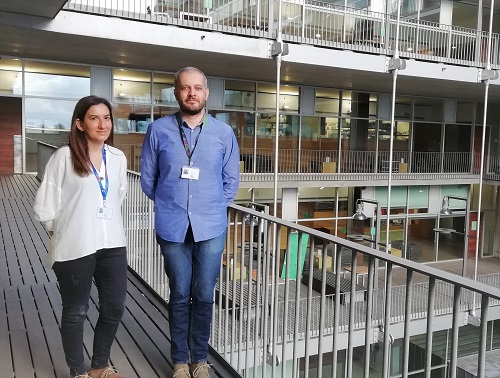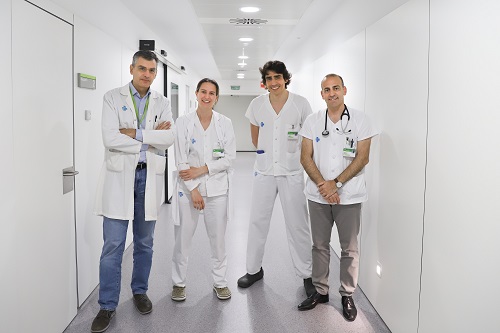
28/04/2022 - Press release
The study was carried out jointly by Germans Trias Hospital and the Hospital del Mar Medical Research Institute (IMIM-Hospital del Mar). The research team compared blood samples from 58 cases of patients hospitalised for heart attack complicated by primary ventricular fibrillation with those of 116 people who did not suffer this complication.
A team of researchers from Germans Trias Hospital, the Hospital del Mar Medical Research Institute (IMIM-Hospital del Mar) and the CIBER on cardiovascular diseases has demonstrated that regular consumption of foods rich in linoleic acid can help to reduce the risk of cardiac arrest due to ventricular fibrillation during the acute phase of a heart attack. The results of the study have been published in the journal Scientific Reports.

La Iolanda Lázaro i l'Aleix Sala-Vila, membres de l'equip d'investigadors de l'IMIM-Hospital del Mar

Equip d'investigadors de l'Hospital Germans Trias i Pujol
To reach these conclusions, the researchers quantified the levels of a number of dietary fats in the patients' blood at the time they were admitted for heart attack. Specifically, samples from 58 patients who had primary ventricular fibrillation in the first two days of hospital stay were studied and compared with samples from 116 patients who also suffered a heart attack and had similar characteristics, but who did not have ventricular fibrillation. The researchers found that the risk of ventricular fibrillation was lower in patients who had high levels of linoleic acid in their blood.
For Teresa Oliveras, a cardiologist at Germans Trias and co-principal investigator on the study, the relevance of this finding is that "It provides evidence of a modifiable lifestyle factor, diet, which is related to a potential reduction in sudden arrhythmic death in the context of acute ischaemia. Incorporating foods rich in linoleic acid (such as nuts and seed oils) into the diet of patients at cardiovascular risk therefore appears to be an integrative strategy for improving their prognosis if they suffer a heart attack."
Polyunsaturated fatty acids include mostly omega-3 and omega-6. The heart-healthy effects of omega-3s are well known. In contrast, the benefits of omega-6 have been widely questioned until very recently.
For Aleix Sala, head of the blood fatty acid determination section at the IMIM, "Being able to look at levels of these fats in the blood gives us information on two levels. Firstly, it helps us to determine the exact intake of certain types of fat in the weeks before the blood sample is taken. Secondly, it tells us how well protected the cells of the heart are in terms of coping with the damage that a heart attack can cause."
Ventricular fibrillation, a potentially lethal arrhythmia
Cardiovascular disease is one of the leading causes of death in Western countries. Its most serious complication is sudden cardiac death, with acute myocardial infarction being the main cause.
The vast majority of heart attacks present with oppressive chest pain, but in some patients they manifest directly as cardiac arrest, mainly caused by ventricular fibrillation, a potentially lethal arrhythmia responsible for most pre-hospital sudden cardiac deaths.
Although its precise incidence is unknown, it is estimated that 5-10% of heart attack patients present with ventricular fibrillation during the first 48 hours after the onset of symptoms (so-called 'primary ventricular fibrillation') and there is only one treatment effective at reversing it: electrical defibrillation.
Over recent decades, thanks to therapeutic advances and the consolidation of reperfusion networks, mortality from infarction has decreased markedly, to its current 5-7%. However, primary ventricular fibrillation figures have remained stable, probably because in most cases this occurs before the patient reaches the hospital: it is, therefore, still the most serious complication in the acute phase of a heart attack and represents a poor prognostic factor in the short term.
Reference article
Teresa Oliveras, Iolanda Lázaro, Ferran Rueda, Germán Cediel, Deepak L. Bhatt, Montserrat Fitó, Francisco Madrid Gambin, Oscar J. Pozo, William S. Harris, Cosme García García, Aleix Sala Vila, Antoni Bayés Genís. Circulating linoleic acid at the time of myocardial infarction and risk of primary ventricular fbrillation. Scientific Reports.
Servei de Comunicació:
Marta Calsina Freixas(ELIMINAR)
Tel:
(+34) 93 316 06 80
Doctor Aiguader, 88
08226 Barcelona
© Institut Hospital del Mar
d'Investigacions MèdiquesLegal Notice and Privacy Policy | Cookie Policy | Site Index | Accessibility | Find Us | Contact